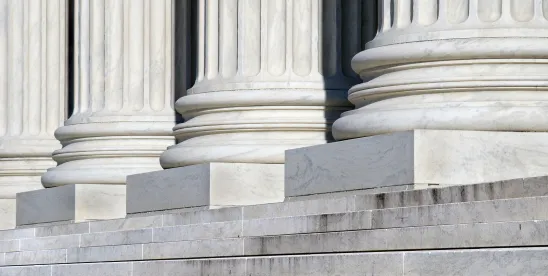As the end of the term seems to be rushing towards us, the U.S. Supreme Court issued six more opinions yesterday, mostly unanimous or near unanimous.
In other words, the Court is clearing the shelves of the “easy ones.” More profound disagreements are likely on the horizon, but not this time. Notably, in one case that was not unanimous, we find Justice Jackson and Justice Thomas together in a concurring opinion. While not landmarks, yesterday’s “Pick Six” are all interesting cases, several of which will affect the practices of many readers of this blog, and one of them hearkens back nostalgically to a case this writer argued and won years ago. So, let’s get going.
A.J.T. v. Oseo Area Schools, Independent School District No. 279 was a disabilities case brought under three statutes familiar to many lawyers who follow this blog. As described by Chief Justice Roberts writing for a unanimous Court (four Justices also concurring in two separate opinions), those laws afford protections for children with disabilities in public schools.
Section 504 of the Rehabilitation Act of 1973 provides that no qualified individual with a disability shall be excluded from participation in, denied the benefits of, or subjected to discrimination under any federally funded program solely by reason of her or his disability. Similarly, Title II of the Americans with Disabilities Act (ADA) prohibits qualified individuals with disabilities from being excluded from or denied the benefits of a public entity’s services, programs, or activities by reason of disability . . . [and] the Individuals with Disabilities Education Act (IDEA) offers federal funds to States in exchange for the commitment to furnish the core guarantee of a “free appropriate public education” to children in public schools with certain physical or intellectual disabilities.”
The Chief Justice goes on to observe that IDEA guarantees “the provision of an ‘individualized educational program,’ (IEP) which ‘spells out’ a plan to meet all of the educational needs of a child with a qualifying disability.”
The petitioner here, A.J.T., is a young girl with a rare form of epilepsy that limits her physical and cognitive functioning. She experiences frequent seizures that inhibit her learning abilities at the start of the day, but is alert and able to learn during the afternoon and evening. Although she was given evening instruction in a previous school district, that was denied her in her new school district, where she received only 4.25 hours of daily instruction, as opposed to the typical 6.5-hour school days afforded to non-disabled students. Faced with further cuts to A.J.T.’s school day, her parents filed an IDEA administrative complaint alleging that the school’s refusal to provide after-hours instruction denied A.J.T. a free, appropriate public education. An administrative law judge ruled in her favor, a decision that lower courts affirmed.
A.J.T.’s parents then sued under the ADA and the Rehabilitation Act, requesting a permanent injunction, reimbursement for certain costs, and compensatory damages. The U.S. District Court for the District of Minnesota granted summary judgment for the school, and the U.S. Court of Appeals for the Eighth Circuit affirmed, holding that a school district’s failure to provide a reasonable accommodation was not enough to state a prima facie case of discrimination under a precedent that requires proof of school officials’ bad faith or gross misjudgment.
As happened last week in a discrimination case in which the Court leveled the playing field for plaintiffs of majority and minority groups, all the Justices yesterday levelled another playing field, agreeing that schoolchildren bringing ADA and Rehabilitation Act claims related to their education are not required to make a heightened showing of “bad faith or gross misjudgment,” but instead are subject to the same standards that apply in other disability discrimination laws. In sum, text (or the absence of it) rules again.
Soto v. United States was also decided unanimously, with Justice Thomas writing for the Court. This is another statutory coverage case, here under the Barring Act, which establishes default settlement procedures for claims against the government and subjects most claims to a six-year limitations period. However, the Barring Act and its limitations period are displaced where “another law” confers authority to settle a claim against the government. In 2002, Congress enacted a statute providing “combat-related special compensation” (CRSC) up to the amount of retired pay that was waived under predecessor statutes.
Simon Soto is a former Marine who served from 2000 to 2006, when he was medically retired with a 100 percent disability related to post-traumatic stress disorder. In 2016, Soto applied for CRSC payments. His application was approved, but his retroactive compensation was limited to six years, citing the Barring Act. Soto then filed a class action lawsuit challenging the application of the Barring Act’s six-year limitations period on the ground that the CRSC statute constitutes “another law” that provides its own settlement mechanism.
In a Clintonian exercise of word parsing over the meaning of the term “settle,” Justice Thomas wrote that the Barring Act, though unspecific, confers authority to settle CRSC claims. “The term ‘settle’ in the Government-claims context refers to determining the validity of a claim and the amount of money a claimant is due. . . . A statute confers settlement authority so long as it vests an entity with these powers. While the most straightforward way to confer settlement authority may be to use the term ‘settle,’ Congress need not ‘use magic words.’”
I’ve been writing about textual literalism in this blog for weeks now, but this one is a clear exception. Moreover, its reasoning might apply to other claims-related statutes, so be aware.
Parrish v. United States wasn’t unanimous. This was the one where Justices Thomas and Jackson concurred, and Justice Sotomayor wrote for the Court while Justice Gorsuch dissented. This case, no doubt, will be taught early on in future civil procedure classes. As Justice Sotomayor explained, in civil litigation, filing an untimely late notice of appeal deprives a court of appeals of jurisdiction over the appeal. But dilatory litigants who miss the appeal deadline because they haven’t timely received the district court’s decision have been authorized by Congress to have the appeal period reopened. But what of a losing litigant who files a notice of appeal before a court acts? Must he or she file a second notice after reopening? Justice Sotomayor explains:
The answer is no. A notice of appeal filed after the original deadline but before reopening is late with respect to the original appeal period, but merely early with respect to the reopened one. Precedent teaches that a premature notice of appeal, if otherwise adequate, relates forward to the date of the order making the appeal possible. So a notice filed before reopening relates forward to the date reopening is granted, making a second notice unnecessary. Because the Fourth Circuit held otherwise, this Court now reverses.
We encourage compliance with deadlines around here, but with respect to the timing of notices of appeal, the Parrish case furnishes constructive guidance.
The Court was unanimous again in Martin v. United States. This is the case involving the so-called “discretionary-function exception” to the Federal Tort Claims Act (FTCA), 28 U. S. C. §2671 et seq., a feature of the law about which this writer, while in government service, was able to convince the Court should be applied very broadly. Indeed, Justice Scalia wrote that I should have sought even broader relief. Well, if he were around today, he’d likely have been most enthusiastic about the Martin case. Curtrina Martin, whose house was mistakenly raided by the FBI, would surely agree.
In October of 2017, an FBI SWAT team misread a warrant and raided the wrong house in suburban Atlanta, Georgia, causing injuries to its occupants. Instead of an expected gang hideout, the officers breached a quiet family home. Its residents sued the United States under the FTCA, seeking damages resulting from the officers’ alleged negligent and intentional actions during the raid. The government prevailed in the district court and in the Eleventh Circuit, which applied “a unique approach to FTCA claims.” While the FTCA famously waives sovereign immunity from suit as to certain torts committed by federal employees acting within the scope of their employment, that waiver is subject to two statutory exceptions. One exception is for 11 enumerated intentional torts, and the second bars claims against the government that are based on an official’s exercise of discretionary functions.
Practicing textual gymnastics, the Eleventh Circuit held that the law enforcement proviso protected petitioners’ intentional-tort claims from both the intentional-tort and discretionary-function exceptions. The court dismissed the petitioners’ negligence claims under the discretionary-function exception, reasoning that the FBI enjoyed discretion in preparing for the warrant execution. However, in vacating the judgment below, the Supreme Court held that the law enforcement proviso overrides only the intentional-tort exception, not the discretionary-function exception or other exceptions. Again, looking strictly to text, the Court reasoned that its terms and structure demonstrate that the law enforcement proviso applies only to the intentional-tort exception.
That said, the Court did not attempt to resolve remaining questions as to the circumstances under which the discretionary-function exception may ever foreclose a suit like this one. The Court held that that is a matter that requires the Eleventh Circuit to examine carefully in the first instance.
In Commissioner of Internal Revenue v. Zuch, the issue was whether the U.S. Tax Court had jurisdiction over appeals from collection due process hearings when there is no longer an ongoing levy. The dispute arose when Jennifer Zuch and her then-husband, Patrick Gennardo, filed untimely federal tax returns. Gennardo subsequently compromised outstanding tax liabilities that implicated $50,000 in estimated tax payments, which the IRS applied to Gennardo’s account. Zuch amended her tax return to report additional income, which resulted in an additional $28,000 in taxes due. But she claimed that the IRS should have credited the couple’s $50,000 payment to her account, entitling her to a $22,000 refund. Unsurprisingly, the IRS disagreed and sought to collect her unpaid taxes by placing a levy on her property, pursuant to its authority under 26 U. S. C. §6331(a).
While multi-year agency and Tax Court proceedings were ongoing, Zuch filed several annual tax returns showing overpayments. Instead of refunding them, the IRS applied them to her earlier liability until it reached zero. Thereupon, the IRS moved to dismiss the Tax Court proceeding as moot, arguing that the Tax Court lacked jurisdiction because the IRS no longer had a basis to have a levy on Zuch’s property. On appeal from the Tax Court, the Third Circuit vacated the dismissal, holding that the IRS’s abandonment of the levy did not moot the Tax Court proceedings. The Supreme Court reversed, holding that the Tax Court lacks jurisdiction to resolve disputes between a taxpayer and the IRS when the IRS is no longer pursuing a levy.
The fact that the case concerned a “levy,” not a mere suit for a refund of disputed taxes paid, was determinative. When Zuch no longer owed unpaid taxes, there was no basis for a levy and thus no relevant “determination” to review. At that point, the Tax Court lacked jurisdiction to resolve any tax liability suit independent of any ongoing collection effort. Zuch’s proper recourse for alleged tax overpayments is to sue for a refund, which she has already done.
The restriction of successive habeas corpus petitions returned to the Court in Rivers v. Guerrero, and the Justices again ruled unanimously, this time per Justice Jackson. The petitioner, Danny Rivers, had been convicted in state court of sexually abusing a child. After unsuccessfully seeking a direct appeal and habeas relief at the state level, he filed his first federal habeas petition under 28 U. S. C. §2254 in August 2017, asserting the usual claims of ineffective assistance of counsel and prosecutorial misconduct. That petition was denied in September 2018, and Rivers appealed to the Fifth Circuit, which granted a certificate of appealability on his ineffective assistance claim in July 2020.
While that appeal was pending, Rivers obtained a file containing a state investigator’s report that he believed was exculpatory. After the Fifth Circuit denied his request to supplement the record on appeal, he filed a second petition in the Northern District of Texas alleging newly discovered evidence. The district court classified this second-in-time filing as a “second or successive” habeas application under §2244(b) and transferred it to the Fifth Circuit for authorization to file. Rivers appealed the transfer order, and the Fifth Circuit affirmed, holding that the fact that Rivers’s first petition was still on appeal did not permit him to circumvent the requirements for successive petitions under §2244 as to his second filing.
Again, a “liberal” Justice outlines what many would describe as a “conservative” approach to text, as the Court unanimously held that when a district court has entered judgment with respect to a first filed habeas petition, a second-in-time filing qualifies as a prohibited “second or successive application” properly subject to the requirements of §2244(b). In doing so, the Court addressed the Antiterrorism and Effective Death Penalty Act of 1996, which contains several significant procedural barriers that strictly limit a court’s ability to hear “claim[s] presented” in any “second or successive habeas corpus application” even though it was made while the district court’s decision denying his first petition was still on appeal.
Again, the latest six opinions reflect matters that have not proved particularly controversial to the Justices. However, there are still several weeks to go before the summer break. One can safely assume that the recent clear weather might be punctuated by a few storms.




 />i
/>i

